LEBANON CIVIL WAR
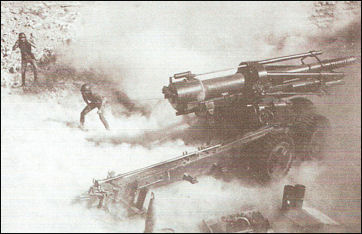
Lebanese Forces Lebanon endured a brutal civil war that lasted for 15 years from 1975 to 1990. Regarded as the Middle East’s longest, dirtiest and most deadly civil war, it was fought between rival political parties, each with ties to a religious group, and was muddled by pressures from the outside, namely Syria, Israel and terrorist groups such as Hezbollah.
Concerns by Christians that they were going to lose power to the more numerous Muslims if a true system of representation, based on population numbers, was set up was the at core of the conflict. Particularly troubling to Christians were efforts by some Islamic groups to create an Islamic state in Lebanon. The situation became complicated as each side pursued alliances with groups and nations outside Lebanon. These groups provided weapons.
The civil war left Beirut a ravaged heap. Around 150,000 were killed, 85,000 of them in Beirut, and hundreds of thousands were wounded. Around 700,000 people, a sixth of the population, fled their homes and became internally displaced
Most of the fighting was carried out by dozens of private well-armed militias that were organized themselves into two camps divided over the presence of the PLO in Lebanon. One group was comprised of mainly of Christian militias, sometimes aligned with Israel. The other was comprised of Muslim groups, sometimes aligned with the PLO.
The fighting occurred in spurts and was complicated by the incursions and occupations of the PLO, Syria and Israel. The first wave of fighting lasted from 1975 to 1976. By 1977, many people thought the civil war had ended and plans were made to rebuild Beirut. Violence erupted again in the early 1980s. Again, by 1983, people thought the violence ended, but it resumed again.
Israeli Invades Lebanon in 1978 and 1982

Arafat in Lebanon In March 1978, Israel invaded southern Lebanon, following a Lebanon-based terrorist attack in Israel. Israel’s aim of the so-called “Litani operation” was to set up security zone in southern Lebanon to protect northern Israel from cross-border attacks by the PLO. The Israeli invasion marked the beginning of an Israeli occupation of southern Lebanon that lasted from 1978 to 2000. The Israelis set up a proxy army, the South Lebanon Army (SLA) led by a half-mad Christian Lebanese army general. Israel’s enemies were a collections of militias, none of them possessing a single modern tank. Three months after the March 1978 invasion Israel withdrew to allow a 6,000-man United Nations peacekeeping force to move in but continued to support Christian militias.
In April 1982, in attack orchestrated by Israeli defense minister Ariel Sharon, Israeli jets began bombing PLO strongholds in Lebanon. On June 6, responding to rocket attacks in Israel from Lebanon and the wounding of the Israeli ambassador in London by Abu Nidal, 70,000 Israeli troops invaded southern Lebanon with a coordinated land, sea and air attack. The Israelis swept through southern Lebanon and laid waste to 900 square miles of Lebanese land and shelled and bombed Beirut.
Israel’s excuse for entering Lebanon were rather flimsy. The rocket attacks from Lebanon had been taking place for a long time and Abu Nidal was an enemy not an ally of the PLO, a target of the incursions into Lebanon. In the early 1980s, Lebanese Christians had begun demanding Syrian troops leave Lebanon. Israel viewed the invasion as chance to defeat the PLO, and deal set backs to the Syrians and their enemies in Lebanon.
The Israelis were welcomed with showers of rice, rose water and flower petals from Christians, who saw them as protectors. Realizing that could not defeat the Israelis in a conventional battle, Syria’s Assad conceded Lebanon to the Israelis. The Israelis quickly took over the southern third of Lebanon, driving out Islamic guerillas and destroying Syrian missile installations, and installing their man as the president of Lebanon.
Impact of the Israeli Invasion of Lebanon
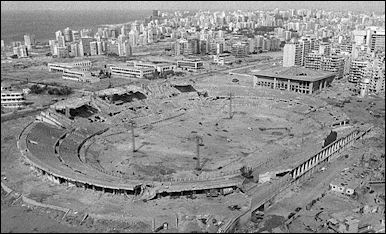
PLO ammunition in a stadium in 1982 Israeli forces were furious with Sharon for leading them into Beirut, far beyond their initial mission. Within two months 1,100 Israeli soldiers had died and thousands, maybe as many as 15,000, Palestinians and Lebanese died. Most of them civilians killed in Israeli rocket attacks and air raids. Tens of thousands of people in southern Lebanon were forced to abandon their homes. Many fled towards Beirut, presuming they could find refuge there, only to find what was happening there was even worse than what was happening in their villages.
After the 1982 invasion Israel remained in Lebanon for 18 years. Lebanon became like Israel’s Vietnam. The original intent was to drive the PLO out of Lebanon, neutralize Syria and force the Palestinians in the West Bank and the Gaza Strip accept to Israeli rule. What emerged was a quagmire — complete with massacres, new terrorist group, paramilitary groups — from which Israel could not extricate itself.
Prime Minister Ehud Barak told the New York, “In the first 25 years, we had a strong sense that the Arab world wants to destroy us, we are fighting for our very existence. It gave us a lot of strength. But when we went into Lebanon questions began to appear. People asked themselves, “What the hell are we doing here?”
Massacre at the Palestinian Camps in Lebanon
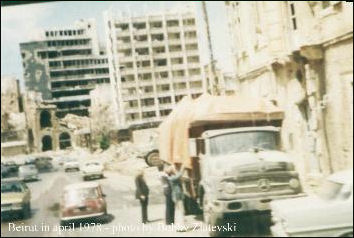
Beirut Perhaps the most horrible Israeli-inflicted atrocity ever occurred on September 17 and 18, 1982, when at least 700 and perhaps as many as 2,000 Palestinians, including women and children, were massacred at the refugee camps in Shatila (Chatila) and Sabra (Chabra), outside of West Beirut, by a Lebanese Christian militiamen while Israeli soldiers stood by and did nothing. The PLO had been driven out of the area by this time so there were few people to defend the unarmed civilians in the camps. The world was outraged by Israel’s role in the slaughter.
The Christian militiamen were known as Phalangists. Supported and uniformed by the Israelis and inspired by German fascist groups, the Phalangists had been fighting the Palestinians for a long time and had come to detest them. They were responsible for the deaths of thousands of surrendering Palestinians in the Tel el-Zaatar camp in 1976. The Phalangists were particularly angry and agitated in 1982 because their leader, president-elect Gemayel, had just been assassinated. Sharon had authorized the Phalangists to enter the refugee camps. Sharon said he “never imagined” such a massacre would be possible.
A report released in 1983 by commission that studied the tragedy concluded that based on the Phalangist’s violent history that a rash of violence was at least possible, and therefore measures should have been taken to prevent it. After the report was released, Sharon was found “indirectly responsible” and forced to resign. The Israeli division commander in Beirut was sharply rebuked for his role and was relieved of his post. He later said he acted “badly” and was “oblivious” to the events that occurred.
Eyewitness Account of the Massacre at the Palestinian Camps in Lebanon

Massacre of Palestinians in Shatila Describing what he saw British journalist Robert Fisk wrote, “They were everywhere, in the road, in laneways, in backyards and broken rooms, beneath crumpled masonry and across the top of garbage tops. The murderers — the Christian militiamen who Israel had let into the camp to “flush out terrorists” fourteen hours before — had only just left. In some cases the blood was still wet on the ground. When we had seen a hundred bodies, we stopped counting.” [Source: John Carey, “Eyewitness to History”, Avon Books, 1987]
“Even twenty-four hours after the massacre of the Palestinians at Chatila had ended, no one was sure how many had been killed there. Down every alleyway there were corpses — women, young men, babies and grandparents — lying in lazy and terrible profusion where they had been knifed or machine-gunned to death...There were signs of hastily dug mass graves. Perhaps a thousand people were butchered here, perhaps half that number again.”
“The full story of what happened at Chatial on Friday night and Saturday morning may never be known, for most of the witnesses are either dead or would never wish to reveal their guilt...What is quite certain is that at six o’clock on Friday night, truckloads of gunmen in uniform — and wearing the badges — of the right-wing Christian Phalange militia and Major Saad Haddad’s renegade army from Southern Lebanon were seen by reporters entering the southern gate of the camp.”
“There were bonfires inside and the sound of heavy gunfire. Israeli troops and armor were standing round the perimeter of the camp and made no attempt to stop the gunmen — who have been their allies since the invasion of Lebanon — going in...A spokesman for the Israeli foreign ministry was to say later that the militias had been sent into Chatila to hunt down some of the 2000 Palestinian “terrorists” whom the Israelis alleged were still in the camp.”
“There had been fighting inside the camp. The road was slippery with cartridge cases and ammunition clips near the Sabra mosque and some of the equipment was of the Soviet type used by the Palestinians. There had clearly been guerillas here.”
Dead After the Massacre at the Palestinian Camps in Lebanon
“Buildings had all been dynamited to the ground. There were cartridge cases across the main road and clouds of flies swarmed across the rubble, Down a laneway to our right, no more than 50 yards from the entrance, there lay a pile of corpses...There were more than a dozen of them whose arms and legs had become entangled with each other in the agony of death. All had been shot at point blank range through the right or left cheek, the bullet tearing way a line of flesh up to the ear and entering the brain. Some had vivid crimson scars down the left side of their throats. One had been castrated. Their eyes were open, and the flies had begun to gather. The youngest was perhaps only twelve or thirteen years old.”
“On the other side of the main road...we found the bodies of five women and several children. The women were middle-aged, and their corpses lay draped over a pile or rubble. One lay on her back, her dress torn open, and the head of a little girl emerging from behind her. The girl had short, dark curly hair and her eyes were staring at us and there was a frown on her face. She was dead....Another child lay on the roadway like a discarded flower, her white dress stained with mud and dust. She could have been no more than three years old. The back of her head had been blown away by a bullet fired into her brain. One of the woman also held a tiny baby to her body. The bullet had passed through her breast had killed the baby too.”
“Below a low wall a line of young men and boys lay prostrated. They had been shot in the back against the wall in a ritual execution, and had lay, at once pathetic and terrible, where they had fallen....There may have been twelve or twenty bodies there. Some lay beneath others.”
A girl who was 12 at the time later told Fisk, “At the end of the alleyway outside our home, we were all shocked by what we saw. I saw corpses there, seven deep, some decapitated, others with their throat slit. One of our neighbors was lying there, Um Ahmed Saad, and her body had grown big with the heat. Her hands had been chopped off at the wrist. She used to wear a lot of bracelets, a lot of gold. The phalange obviously wanted the gold.”
An Israeli officer told Fisk, “The Haddad men were supposed to go in with us. We had to shoot two of them yesterday. We killed one and wounded another. Two more we took away. They were doing a bad thing.” A young radio operator then said, “We Israelis don’t do that sort of thing. It was the Christians.”
One survivor later told Fisk. “The Phalange were led by Elie Hobeika but who sent them into the camps? The Israelis. And who was the defense minister Sharon. They put their tanks around the camp. I was part of a delegation that tried to negotiate with them. We carried white flags. When we got near , there was a man’s voice on a loudspeaker telling is to have out our identity cards ready. But I didn’t have my ID. So I went back home... It it turned out the loudspeaker was used by Phalangits.... They murder all the men in my delegation. I was the only one to survive
Impact of the Massacres and Israel’s Withdrawal from Lebanon
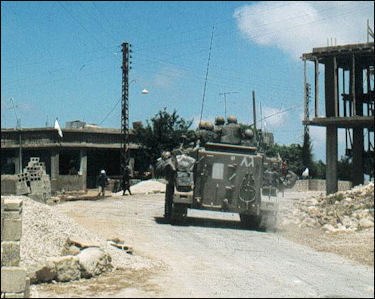
Israeli tanks in Lebanon From June to August 1982 Israeli losses: 271 dead and 1,953 wounded; Arab losses: 17,000 to 19,000 killed, mostly civilians. The Lebanese commander who led the attack at Sabra and Shatila later became a minister in the Syrian-backed Lebanese government.
Israel’s high moral ground that had been called “a light unto nations” had been lost through its occupation of Lebanon. Thousands of Israelis took to the streets in the country’s first large anti-war protests. Some even wanted Sharon to be tried for war crimes by a tribunal in Europe.
In the fall of 1982, Syrian, PLO and Israeli troops withdrew from Beirut and took up positions in the Lebanese countryside. In 1983, the Lebanese government signed a treaty with Israel but tore it up a year later. Two Israeli military buildings were blown up in Lebanon in the 1980s, killing dozens of soldiers. In 1985, Israeli raided the PLO headquarters in Tunis, killing 70 people.
In 1982, the United States, France and a multinational force tried to install a friendly democratic government. Their efforts failed due to local resistance and international opposition. A number of countries got involved in the Lebanon mess at one time or another. They included the United States, France, Britain, Iran and Iraq in addition to Syria and Israel.
In 1985, Israel withdrew from most of Lebanon. It established 40-mile-long, nine-mile-wide security zone, which it occupied in southern Lebanon for a decade and a half. Israel did not leave Lebanon completely until 2000.
Anarchy and Fighting Between Christian, Druze and Muslims

damage in Beirut still visible in 2006 Meanwhile in Beirut, Christian and Muslim militias continued to arm themselves to the teeth. With no political agreement, Muslims and Christians sides were unable to peacefully work out their differences. Fighting broke out frequently. In the early 1980s there was fighting between Christians and Druze in the central Chouf mountains. With Israeli backing the Christians made advances but when the Israelis redeployed further south, the Druze won back territory. Villages that formally had been mixed Christian and Druze became all Druze. Fighting also broke out between the Lebanon army and Muslim militias. Attacks were also directed at the American and French troops in the multinational force that was present in Lebanon.
During much of the 1980s, Lebanon was such a violent place few foreigner dared go there. Each militia guarded its small piece of turf. People stopped working because their salaries shrunk to near nothing. Hospitals were understaffed and had no supplies. There were long periods without water and electricity.
Describing Beirut in the early 1980s, William Ellis wrote in National Geographic, "This was no simply brutal warfare between Christians and Muslims. There were alliances, counterallainces, unlikely allies and reluctant enemies...There was no central government with authority, no army capable of keeping order. Boys no older than 14 stood on the streets, making menacing sweeping motions with their automatic Kalashnikov rifles. Shells whined overhead, while on the streets car bombs were set off to thick and mushy sounds that seemed to have rumbled up from the depths of hell. Garbage in west Beirut streets went uncollected and stray cats grew grotesquely fat."
Some of the heaviest fighting occurred near the American University in Beirut medical center, which was both a war zone and a place to bring the dead and wounded. Car bombs exploded near the entrance in the parking lot. Clinics were hit with artillery shells. Seven people were killed by a suicide bomber who came in the hospital with a bomb in a box of chocolates. Patients kept automatic weapons under their pillows. Gun battles broke out in the wards. Doctors were ordered at gunpoint who to treat first. Nurses committed suicide and had bombs placed in their cars. [Source: “An American Nurse Amidst Chaos” by Gladys Mouro (Syracuse University Press, 2000)]
Car Bombs

Beirut Embassy Car bombs were a fixture of the violence in Lebanon. According to one report there were 3,641 car bombings which killed 4,386 people and wounded 6,784 in Lebanon during the period of civil war. Describing one car bomb attack in July 1983,Thomas Friedman wrote in the New York Times: “All car-bomb scenes start to look the same after a while. You stop noticing the stunned pedestrians with blood trickling down their cheeks who happened to be standing on the street when the lethal Mercedes — the favorite choice of Beirut car bombers — suddenly turns into a ball of flame. You stop seeing the smoldering charred carcasses of the other automobiles engulfed in the blast or the chaos of rescue workers as they scurry around on tip toe between the shards of glass and twisted car parts to pry out the dead and wounded.”
“Instead, after a while you find your mind focusing on the incongruities: the juicy roast chickens that were blown all over the street from an adjacent restaurant but somehow still looks good enough to eat, or the smell of liquor from a shelf full of broken Johnnie Walker bottles...I start to notice the leaves: when a car packed with 100 slicks of dynamite explodes on a crowded street the force of the blast knocks all the leaves off the tree and the road is left choking with them like an autumn lawn.”
“Life in this city is absurd not because people get killed but because they get killed playing tennis or lying on the beach or shopping in a market or driving home from work...Most Beirutis will tell you that of all the forms of violence they live with nothing terrifies them more than car bombs — not only because the are utterly indiscriminate, but because they transform a totally innocuous object from daily life into a daily weapon.”
Bombing Attack of the U.S. Marine Barracks
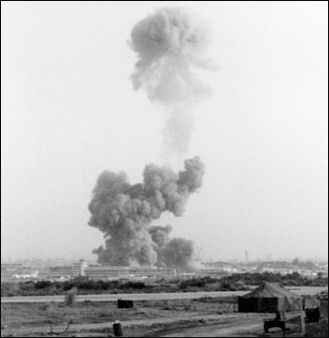
Marine barracks bombing In April 1983, 63 people were killed, including 17 Americans, when a van packed with explosives and driven by a suicide bomber exploded outside into United States seaside embassy in Beirut. Islamic Jihad, a pro-Iranian group, took credit for the attack. In September 1983, a explosive-laden station wagon hit a concrete block before detonating in front of the United States embassy annex in East Beirut. Eleven people were killed including the driver. In September 1984, 23 people were killed, including two Americans, in a suicide car bomb attack on U.S. Embassy in Beirut. The embassy had been moved after the 1983 attack.
On October 23, 1983, 241 U.S. Marines and 58 French paratroopers were killed in bombings that took place just three seconds apart at the Marine barracks in Beirut and a French facility three miles away. The attack on the Marines barrack was carried out by a suicide driver in yellow Mercedes truck laden with 12,000 pounds of explosives. The truck broke through gates of a compound near Beirut’s international airport and drove right into the four-story concrete compound used as the Marine battalion headquarters. Another suicide driver hit the French facility. No arrest were ever made and the terrorists are still believed to be in Lebanon. The United States left Lebanon in early 1984.
The bombing of the U.S. Marine barracks in Beirut still ranks as the largest loss of American military life in a single incident since the Battle of Iwo Jima in World War II. The tactic worked from the terrorists point of view. French and American forces withdrew from Lebanon soon after the attack. “We couldn't stay there and run the risk of another suicide attack on the marines,” wrote Ronald Reagan, then America's president, in his memoirs.
Robin Wright wrote in the Washington Post: Both attacks in Lebanon “caught Washington by surprise, despite suicide bombings against the Iraqi Embassy in Beirut in 1981 and an Israeli military headquarters in south Lebanon in 1983. "We at the embassy collectively saw the political situation as improving," said Richard Gannon, the regional security officer at the time. Anne Dammarell, who worked for the U.S. Agency for International Development, vividly remembers being pinned under concrete with 19 broken bones, unable to move as flames approached. She said she decided to gulp smoke to "suffocate before being burned to death. I thought that would be easier." [Source: Robin Wright, Washington Post, April 18, 2008]
“The FBI and the CIA still do not know the identity of the bomber who, 25 years ago, drove a dark delivery van loaded with explosives past the red-and-white-striped security booth straight into the seven-story embassy overlooking the Mediterranean, ripping off the entire front facade. The FBI eventually blamed a cell of Shiite extremists that later evolved into Hezbollah, and said Iran provided aid and direction. But few specifics are known to this day, and no one has been brought to justice, as in many such attacks.
The Marine barracks attack is believed to be have been masterminded by Imad Mughniyah, a Shiite extremist who grew up in poor suburb of Beirut. He was involved in a number of terrorist activities and is regarded as one of the pioneers of modern terrorism. He introduced many tactics that continue to be deadly and effective today: suicide attackers, truck bombs, and using foreigners hostage to achieve political goals.
Mughniyah was the United States’s most sought after terrorist long before anyone had heard of Osama bin Laden. No one is sure what he looks like. There are reports that he has had plastic surgery at least two times. He is believed to be to divide his time between Lebanon and Iran, where he is protected by Iran’s Revolutionary Guard. He is said to have met personally with Osama bin Laden in 1994.
Mughniyah has a $25 million price on his head. He was almost captured in 1995 when it was learned that a commercial airliner on which he was traveling was going to make a stopover in Saudi Arabia. At the last minute the Saudis refused to let the plane land. No arrests were made.
Foreign Hostages in Lebanon
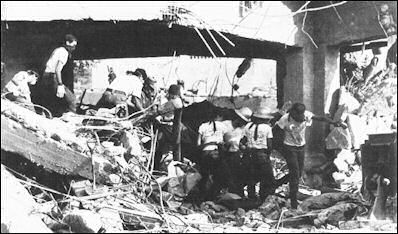
Marine barracks bombing Dozens of Western hostages, including 18 American, were held from 1984 to 1993 in Lebanon during the civil war period. Among the more well-known ones were journalists John MacCarthy and Terry Anderson, Irish schoolteacher Brian Keenan and university administrator Thomas Sutherland. Negotiator Terry Waite, who was trying to secure the release of the hostages, was himself, kidnaped from the Riviera Hotel.
Hezbollah was responsible for some of the kidnapings. Islamic Jihad, a Muslim extremist group supported by Iran, also took foreigners hostage. These groups mostly demanded the release of Palestinians held in foreign jails. Most of the hostages were released through prisoner exchanges. An effort by the administration of U.S. President Ronald Reagan to free the hostages by making a secret arms-for-hostages swap resulted in the Iran-Contra affair.
In 1984, Malcolm Kerr, the president of the American University, was assassinated with gunshots to the head by terrorists near his campus office. In February 1988, Marine Lieut. Col. William R. Higgens, a member of U.N. peacekeeping force, was kidnaped and executed in southern Lebanon by Hezbollah.
The most well-known hostage was Terry Anderson, an AP reporter who has held hostage for 2,454 days (almost seven years), longer than any of the other hostages. He was kidnaped by a car full of pistol-carrying young men in March 1985 while on his way to a tennis match and held until December 1991, more than a year after the civil war was formally over. For long period during his captivity he was shackled and blindfolded.
In the early 2000s, a U.S. judge ordered Iran to pay Anderson $341 million ($300 million of it punitive damages) for treatment that was “savage and cruel by an standards.” Anderson sued Iran using a 1996 law that allows terrorist victims to sue foreign countries. Anderson’s lawyers were able to make a convincing case that Anderson had been kidnaped by Hezbollah and that Hezbollah was supported by Iran.
Other hostages were given awards under the same 1996 law that amounted to tens or hundreds of millions of dollars. Among them was Sunderland, who was held for 6 ½ years, the second longest after Anderson. He was kept shackled in a series of filthy dungeons. He was awarded $323.5 million. At last check no one had collected from Iran but the forrner hostages were given a share of $200 million fund provided by the U.S. government.
End of the Civil War in Lebanon
In February 1987, Syrian troops were invited back into Lebanon by Lebanese prime minister Selim al-Hoss. The Syrians, with tacit approval from the United States, slowly brought the Muslim areas under control.
In September 1988, President Gemayel’s term expired and he appointed a transitional government led by General Michel Aoun to succeed him. General Aoun disbanded the Christian militias and then launched a “war of liberation” against the Syrians in Lebanon. After fierce fighting Aoun was defeated and forced to flee to France in August 1991
The violence mostly ended in late 1990 when Syria defeated the bulk of General Aoun’s forces. With Syrian support, the Lebanese army and police were able to regain control of Beirut in late 1991 and not long after that gained control of the rest of the country. By early 1992, all the surviving foreign hostages were released, and some Syrian troops withdrew from Beirut.
Hezbollah
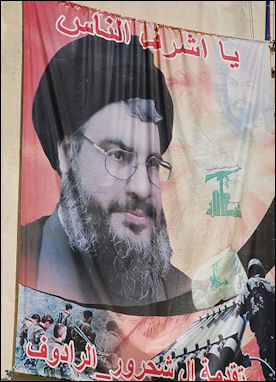
Hezbollah Hassan
Nasrallah poster Hezbollah is a Muslim-extremist-terrorist group that operates out of Lebanon and has a large presence there. Supported mostly by Shiite Muslims and strongest in southern Lebanon, it is involved in politics and providing social services in Lebanon and has fought with Israel and staged terrorist attacks against Israeli targets. Hezbollah means "Party of God.” It is supported by Iran and Syria.
The goals of Hezbollah are to establish an Islamic state in Lebanon, destroy Israel and claim Jerusalem for Islam. Although it has been branded as a terrorist group by Israel and the United States, Hezbollah insists it is primarily a people’s militia intent on ousting a brutal foreign occupier — the Israelis.
Hezbollah was created in 1982 by Iranian Shiite radicals to respond to the Israeli invasion of Lebanon in 1982 and grew out of movements at the college of Najaf in Iraq in the early 1980s. In it early years it had close links with the government of Ayatollah Khomeini in Iran.
During the 1975-90 civil war, Hezbollah was involved in the some of fighting between Christian and Muslim militias. It also harassed people and groups deemed immoral and un-Islamic such merchants in Beirut that sold fishnet stockings and lingerie. However, its primary focus has been Israel. It has staged both military and terrorist attacks against Israel targets.
Hezbollah has been led for a long time by Sheik Hassan Nasrallah. He took over the job in 1992 when he his predecessor and mentor, Sheik Abbas Musawi, was skilled by Israeli planes.
Expert: Magnus Ranstorp, St. Andrews University’s Center of Terrorism Study
Hezbollah Terrorism
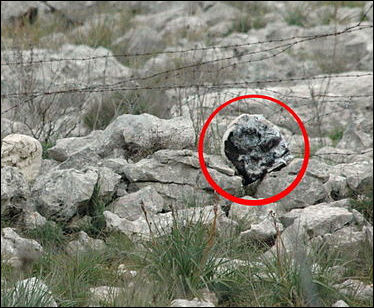
Explosives camouflaged as rocks
found on Lebanon-Israel border Hezbollah is credited with pioneering the use suicide bombs against American and Israeli targets. It is believed to have been responsible for the attack on October 23, 1983 that killed 241 U.S. Marines and 58 French paratroopers. Hezbollah was also responsible for the kidnaping of foreigners during the Lebanese civil war and may have been involved in the bombing of a Jewish center in Buenos Aires in 1994 and an attack on U.S. servicemen in Saudi Arabia in 1997.
Three Hezbollah members, including Imad Mughniyah, carried out the hijacking of TWA flight 847 on June 14, 1985. The flight was hijacked en route from Athens to Rome and forced to land in Beirut. For three days the plane shuttled 8,300 miles around the Mediterranean. At one point a U.S. Navy SEAL diver was forced to kneel and shot in the head. His body was dumped on the tarmac. The hostages remained on the ground for two weeks in Beirut before they were released and the hijackers escaped. One of the hijackers was arrested on terrorist charges in Germany in 1987.
Most of the suicide bombings in Israel have been carried out by Hamas and Islamic Jihad but Hezbollah had its hand in some of the attacks, mostly in southern Lebanon. In the mid 1990s, one Hezbollah suicide bomber charged into an Israeli convoy and killed one Israeli officer and wounded seven soldiers in southern Lebanon.
Hezbollah has supplied terrorist groups in the Palestinian territories such as Hamas with suicide bomber belts and given them the know-how to make their own mortars. They also reportedly bought plans for North-Korea-designed rockets and passed on the designs to Hamas. A Hamas engineering wing built rockets from the designs that had a range of three miles and were used against Israeli targets.
Hezbollah’s armed militia, the Islamic Resistance, fought the Israelis in southern Lebanon. Hezbollah reduced its military activities after Israel withdrew from southern Lebanon in May 2000. Even so it maintains a force of 800 active fighters and 2,000 reservists and possesses large caches of weapons.
Hezbollah, Its International Supporters and Other Terrorist Groups
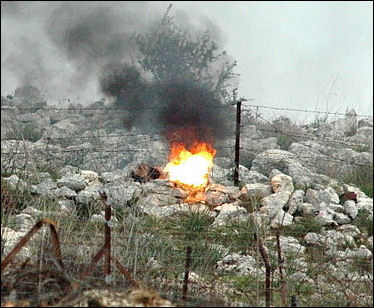
Explosives camouflaged as rocks
found on Lebanon-Israel border Iran has been Hezbollah’s largest financial and military backer. By some estimates $100 million a year was funneled to the organization through powerful Iranian religious foundations. There have been reports that hundreds Hezbollah guerillas received training from Iran’s Revolutionary Guard and that Iran supplied Hezbollah with 8,000 to 10,000 short-range rockets.
Hezbollah has also been supported by the Arab nations in its fight against Israel. Syria has been a major supporter of Hezbollah but it has also been a supporter of Hezbollah’s rivalShiite Muslim rival, the more moderate Shiite party Amal.
It is believed that Hezbollah used diamonds to move money. According to diamond dealers interviewed by the Washington Post they also earned large profits trading in so called “blood diamonds” from Angola, Liberia, Sierra Leone and Congo in Africa. For these transactions Hezbollah has used Lebanese involved in the diamond trade in Africa.
Hezbollah has had contacts with Al-Qaida. On how to handle the United States, one Hezbollah member said he received a message from Osama bin Laden that read: “Bring down their airlines. Prevent the safe passage of their ships. Occupy their embassies. Force the closure of their companies and banks.” There has been some speculation that Hezbollah participated in the September 11th attacks but most terrorism experts believe this probably not the case. Hezbollah has tried to distance itself from Al-Qaida, in part because Al-Qaida is a Sunni group and Hezbollah is a Shiite one.
Hezbollah was once closely allied with Hamas. In the early 2000s they decided to stop cooperating and go their separate ways. The Iranian brought them together and made them patch up their differences so they could be united in the fight against Israel.
Hezbollah operatives have been arrested in the United States for scoping out potential targets. There were reports that Hezbollah was moving into Iraq during the war there in 2003. Syria was allowing Hezbollah members to move through its territory.
Hezbollah and Politics
.jpg)
Hezbollah propaganda Hezbollah is a powerful and influential political party in Lebanon. It holds a number of seats in parliament. Its members regard themselves as spokesmen for Lebanon’s 1.5 million Shiites, who tend be more interested in economic issues than Islamic issues.
To win more broad-based support Hezbollah was has downplayed its conservative agenda and distanced itself from Iran. In an interview with Time, Nasrallah said, “We are for partnership so that the Christians do not ignore the Muslims and the Muslims do not ignore the Christians.”
In the early 2000s Hezbollah had 11 seats in Lebanon’s 128-seat parliament. They could have had more but chose not run in areas were Amal has a large presence. Hezbollah MPs have been most active in trying to secure funds to build roads than introducing Islamic law.
The power vacuum in southern Lebanon brought about by the withdrawal of Israelis was largely filled by Hezbollah, who provided social services, reconstruction aid and development loans there with a kind of shadow government.
Hezbollah Propaganda, Schools and Social Services

Hezbollah organization chart Pictures of Hezbollah “martyrs,” who died in the struggle against Israel, are prominently displayed in Hezbollah-controlled areas. A member of Hezbollah whose son was killed by Israeli soldiers, said, "I thank God and praise him for his ultimate grace and kindness by choosing a martyr from family."
In Hezbollah-controlled areas the are many large billboards with pictures of the Ayatollah Khomeini and Hezbollah leader Nasrallah. Portraits of martyrs who died fighting Israel bear slogans like "For your sake we resist, we liberate, we build a just nation."
Throughout Lebanon you can find souvenir stands that sell small yellow Hezbollah flags for $2 and larger ones for $3 as well as Hezbollah key chains, baseball caps and T-shirts. Outside Beirut's Roman amphitheater in 1995 were banners that read "Hezbollah Welcomes You by His Pioneer Values."
Hezbollah provides social services in southern Lebanon and the Bekaa Valley and runs schools and clinics and supplies water to poor Shiites living in the southern suburbs of Beirut and elsewhere in Lebanon. It also run sports clubs, charities, cultural societies, construction companies and agricultural coops. Among its employees are doctors, nurses, engineers, agronomist, bulldozer operators and veterinarians.
Hezbollah runs a hospital for fighters and civilians wounded in fighting with Israel in Beirut. In southern Lebanon it is the primary sources of social services for 100,000 people. During water shortages there, caused by the cut off of a water pipeline, Hezbollah brought in water with tanker trucks that bore the colors of the Iranian flag — green, white and red. Health care is provided to many villages with mobile clinics, each staffed with its own staff of doctors and nurses,.
Hezbollah schools in southern Beirut have portrait of the Ayatollah Khomeini hanging on the wall next to pictures of ducks, snowmen and jump-roping mice. Female teachers dress in black chadors. The schools indoctrinate the student with a rigid Islamic curriculum. Parents are required to pay their $800 tuition bills in American dollars. The Hezbollah-run Shahed (“Witness”) school in Beirut is regarded as one of the finest schools in Lebanon. A quarter the 1000 students are children of Hezbollah martyrs.
Hezbollah Media and Television
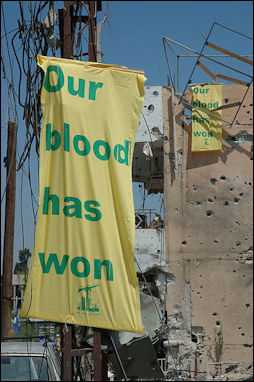
Hezbollah posters Hezbollah has its own weekly newspaper (Al-hid), radio station (Al-Nour), and website. The radio station has been housed in an underground bunker since the period of fighting with Israel. It plays Western classical music and revolutionary songs performed to synthesizer dance rhythms.
Hezbollah’s television station, Manar (“Beacon”) is the number three station in Lebanon and one of the most popular stations in the Middle East. Founded in 1991 as a “station of resistance,” it began as a small time operation with broadcasting capabilities that barely made it to the suburbs of Beirut . With the injection of Iranian funds it grew into a 24-hour-a-day, seven-days-a-week satellite station. Among its aims is attracting viewers with entertainment and then making them good Muslims and getting them riled up about the Palestinians cause so they continues to fight the Israelis rather than trying to make peace with them and wage “psychological warfare against the Zionist enemy.”
Manar broadcasts Egyptian soap operas, quiz shows, Islamic prayers, children’s shows, computer-generated holy men, and news broadcasts of Israeli aggression. The movies it has shown has included “Under California Stars” with Roy Rogers and “Day of the Triffids”, a 1963 British science fiction film about man-eating plants. Manar does its share of editin and censoring. Scenes with sex or alcohol are taken out. American films are sometimes interrupted by voice-over commentaries about American “oppression” to make the point that “in the real world, Americans don’t always win.” [Source: Lara Marlowe, Time, April 13, 1995]
Another aim of Manar is to make money. There are commercials for German chocolate and American detergent. American companies that have run commercials on the Maran have included PepsiCo, Proctor & Gamble and Western Union. Vivaldi’s “Four Seasons” is used in a guerilla recruitment ad.
Hezbollah effectively used the media during its struggle with Israel. Their cameramen took footage of their fights with Israelis and made the footage available to the international press. The images were shown on Israeli televison. They often contradicted what the heavily censored Israeli press was reporting and contributed to the effort to get the Israelis to withdraw from Lebanon. Manar reporters and camera also got close to the action. Several were killed.
Image Sources: Wikimedia Commons
Text Sources: New York Times, Washington Post, Los Angeles Times, Times of London, The Guardian, National Geographic, The New Yorker, Time, Newsweek, Reuters, AP, AFP, Wall Street Journal, The Atlantic Monthly, The Economist, Global Viewpoint (Christian Science Monitor), Foreign Policy, Wikipedia, BBC, CNN, NBC News, Fox News and various books and other publications.
Last updated July 2012
